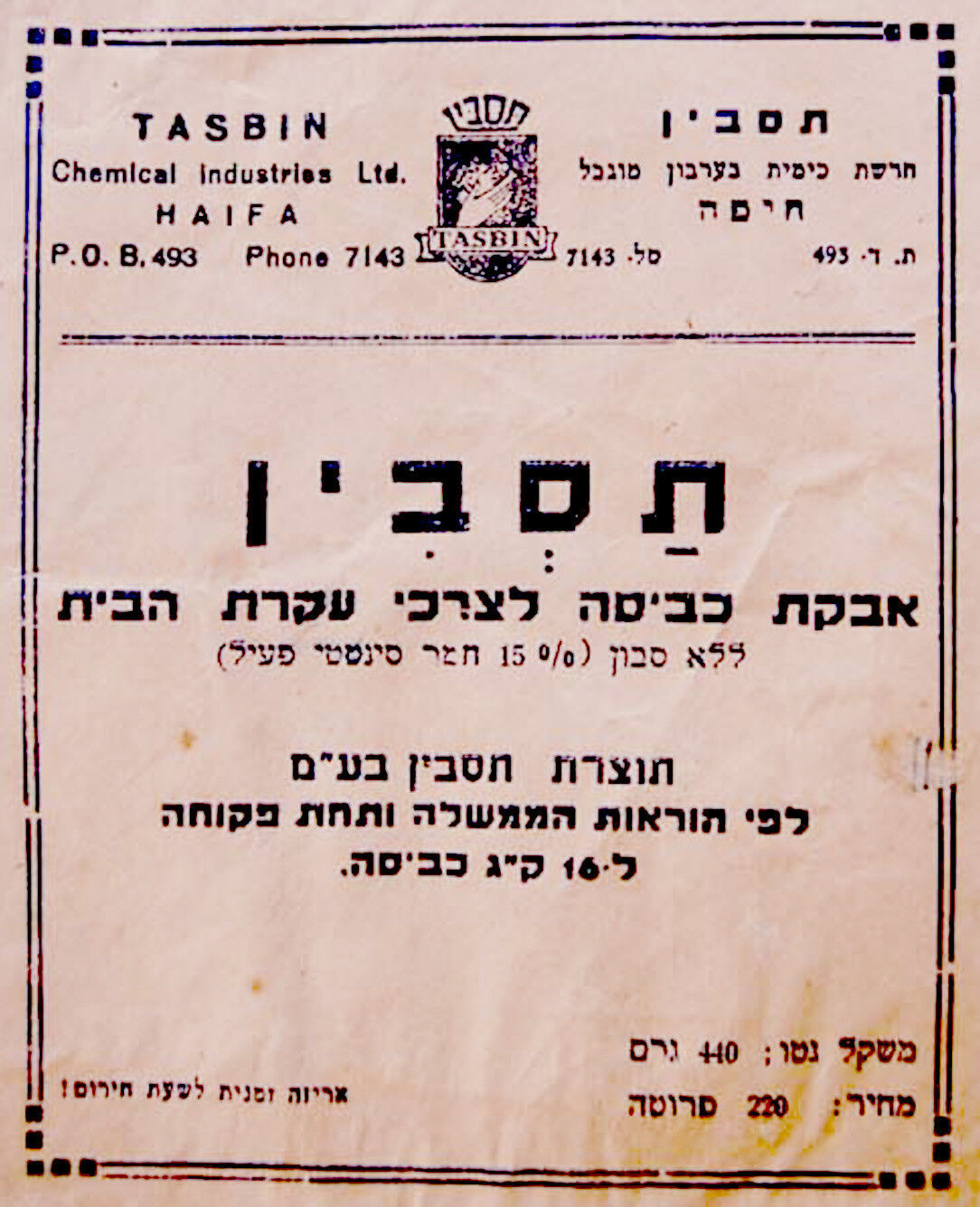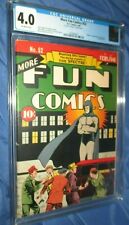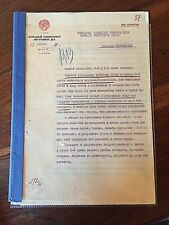1940 War PALESTINE Emergency PAPER WRAPPER Bag WASHING POWDER Hebrew HAIFA SOAP

When you click on links to various merchants on this site and make a purchase, this can result in this site earning a commission. Affiliate programs and affiliations include, but are not limited to, the eBay Partner Network.
1940 War PALESTINE Emergency PAPER WRAPPER Bag WASHING POWDER Hebrew HAIFA SOAP:
$42.50
DESCRIPTION : Here for sale is an ORIGINAL Palestine- Hebrew - Eretz Israeli JEWISH illustrated ADVERTISING paper bag which was designed and manufactured in Israel in the 1940\'s . This WAR TIMES ( WW2 or the Israel 1948-9 WAR OF INDEPENDENCE\" advertising paper bag is all about the TEXT , Not the design. The very archaic text is \" UNDER GOVERNMENT DIRECTION and SUPERVISION\" and also \" PROVISIONAL EMERGENCY PACKAGE ! \" . The washing powder \"TASBIN\" was manufactured by the \"TASBIN\" Chemical Industries LTD. in Haifa, Eretz Israel , Palestine . A nice JUDAICA - ISRAELIANA collectible piece. The SIZE is around 5.5\" x 8 \" . Good condition . Somewhat creased . ( Please look at scan for actual general image ) Will be shipped flat in a protective packaging.PAYMENTS : Payment method accepted : Paypal.SHIPPMENT : Shipp worldwide via registered airmail is $ 19 . Will be shipped flat in a protective packaging.Handling around 5 days after upper left:View of Haifa at Night fromMount Carmel,Bahá\'í World Centre, aerial view of theHaifa University,AhmadiyyaMahmood Mosque, TheCarmelit,National Museum of Science, Technology, and Space, View of Haifa at day from Mount CarmelFlag Coat of ArmsMap of HaifaHaifaLocation in 145/246PALCountry IsraelDistrict HaifaFounded 1st century CEGovernment•Type City•Mayor Yona YahavArea•City 279,591•Urban 600,000•Metro 1,050,000Website thethird-largest cityinIsrael– afterJerusalemandTel Aviv– with a population of 279,591 in 2016. The city of Haifa forms part of theHaifa metropolitan area, the second- or third-most populous metropolitan area in Israel.[3][4]It is home to theBahá\'í World Centre, aUNESCOWorld Heritage Siteand a destination for Bahá\'í pilgrims.[5]Built on the slopes ofMount Carmel, the settlement has a history spanning more than 3,000 years. The earliest known settlement in the vicinity wasTell Abu Hawam, a small port city established in theLate Bronze Age(14th century BCE).[6]In the 3rd century CE, Haifa was known as a dye-making center. Over the millennia, the city has changed hands: being conquered and ruled by and theIsraelis. Since the establishment of the State of Israel in 1948, the Haifa Municipality has governed the city.As of 2016, the city is a majorseaportlocated on Israel\'sMediterraneancoastline in th of Haifacovering 63.7 square kilometres (24.6sqmi). It lies about 90 kilometres (56mi) north of Tel Aviv and is the major regional center of northern Israel. According to researcherJonathan Kis-Lev, Haifa is considered a relative haven for coexistence between Jews and Arabs.[7]Two respected academic institutions, theUniversity of Haifaand theTechnion, are located in Haifa, in addition to the largest k-12 school in Israel, theHebrew Reali School. The city plays an important role inIsrael\'s economy. It is home toMatam, one of the oldest and largest high-tech parks in the country; Haifa also owns the onlyunderground rapid transit systemlocated in Israel, known asThe Carmelit.[8][9]Haifa Bay is a center of heavy industry, petroleum refining and chemical processing. Haifa formerly functioned as the western terminus of anoil pipeline from IraqviaJordan.[10]Contents[hide]1 Etymology2 History2.1 Early history2.2 Crusader, Ayyuoffer and Mamluk rule2.3 Ottoman era2.4 British Mandate2.5 1947–1948 Civil War in Palestine2.6 State of Israel3 Demographics3.1 Religious and ethnic communities4 Geography5 Flora and fauna6 Climate7 Neighborhoods8 Urban development9 Economy9.1 Tourism10 Arts and culture10.1 Museums11 Government11.1 Mayors12 Medical facilities13 Education14 Transportation14.1 Public Transportation14.2 Air and sea transport14.3 Roads15 Sports16 People from Haifa17 Twin towns – sister cities18 See also19 References20 Further reading21 External linksEtymology[edit]Western Haifa from the airThe earliest named settlement within the domain of modern-day Haifa was a city known asSycaminum[11](Tel Shikmona,[12]Hebrew meaning \"mound of theFicus sycomorustrees/bushes,\" (ArabicTell el-SumakorTell es-Sumak, meaning \"mound of thesumaktrees\") preserved and transformed this ancient name and is mentioned once in theMishnah(composed c. 200 CE) for the wild fruits that grow around it.,[12]with locals using it to refer to a coastaltellat the foot of the Carmel Mountains that contains its remains.[12][13]The nameEfafirst appears duringRoman rule, some time after the end of the 1st century, when a Roman fortress and small Jewish settlement were established not far from Tel Shikmona.[11][12]Haifa is also mentioned more than 100 times in theTalmud, a work central toJudaism.[12]HefaorHephainEusebius of Caesarea\'s 4th-century work,Onomasticon(Onom.108, 31), is said to be another name forSycaminus.[14]This synonymizing of the names is explained byMoshe Sharon, who writes that the twin ancient settlements, which he callsHaifa-Sycaminon, gradually expanded into one another, becoming a twin city known by the Greek namesSycaminonorSycaminos Polis.[12]References to this city end with the Byzantine period.[6]Around the 6th century,PorphyreonorPorphyreais mentioned in the writings ofWilliam of Tyre, and while it lies within the area covered by modern Haifa, it was a settlement situated south of Haifa-Sycaminon.[6][12]Following the Arab conquest in the 7th century,Haifawas used to refer to a site established on Tel Shikmona upon what were already the ruins is mentioned by the mid-11th-century Persian chroniclerNasir Khusraw, and the 12th- and 13th-century Arab chroniclers,Muhammad al-IdrisiandYaqut al-Hamawi.[15]TheCrusaders, who captured Haifa briefly in the 12th century, call itCaiphas,[11]and believe its name related toCephas, the Aramaic name ofSimon Peter.[13]Eusebius is also said to have referred toHefaasCaiaphas civitas,[16]andBenjamin of Tudela, the 12th-century Jewish traveller and chronicler, is said to have attributed the city\'s founding toCaiaphas, the Jewish high priest at the time ofJesus.[13]Other spellings in English have al-\'Atiqa(Arabic: \"Ancient Haifa\") is another name used by some locals to refer toTell es-Samak, when it was the site of Haifa while a hamlet of 250 residents, before it was moved in 1764-5 to a new fortified site founded byZahir al-Umar1.5 miles (2.4 kilometres) to the east.[18]The new village, the nucleus of modern Haifa, was first calledal-imara al-jadida(Arabic: \"the new construction\") by some, but others residing there called itHaifa al-Jadida(Arabic: \"New Haifa\") at first, and then simplyHaifa.[2]In the early 20th century,Haifa al \'Atiqawas repopulated with manyArab Christiansin an overall neighborhood in which manyMiddle Eastern Jewswere established inhabitants, as Haifa expanded outward from its new location.[19]The ultimate origin of the nameHaifaremains unclear. One theory holds it derives from the name of the high priest Caiaphas. SomeChristiansbelieve it was named forSaint Peter, whoseAramaicname wasKeiphah.[20]Another theory holds it could be derived from theHebrewverb root חפה (hafa), meaning to cover or shield, i.e. Mount Carmel covers Haifa;[20]others point to a possible origin in the Hebrew word חוֹף (hof), meaningshore, or חוֹף יָפֶה (hof yafe), meaningbeautiful shore.[20][21]History[edit]Main articles:History of HaifaandTimeline of HaifaJars excavated atTell Abu HawamEarly history[edit]A town known today asTell Abu Hawamwas establishedLate Bronze Age(14th century BCE).[6]It was a port and fishing village. During the 6th century BCE, Greek geographerScylaxtold of a city \"between the bay and the Promontory of Zeus\" (i.e., the Carmel) which may be a reference toShikmona, a locality in the Haifa area, during thePersianperiod.[6]ByHellenistictimes, the city had moved to a new site south of what is nowBat Galimbecause the port\'s harbour had become blocked with sand.[6]About the 3rd century CE, the city was first mentioned inTalmudicliterature, as a Jewish fishing village and the home of RabbiAvdimiand other Jewish scholars.[6][22]AGreek-speaking population living along the coast at this time was engaged in commerce.[23]Haifa was located near the town ofShikmona, a center for making the traditionalTekheletdye used in the garments of the high priests in the Temple. Thearchaeological siteof Shikmona is southwest of Bat Galim.[24]Mount Carmel and theKishon Riverare also mentioned in the Bible.[25][26]A grotto on the top of Mount Carmel is known as the \"Cave of Elijah\",[27]traditionally linked to the ProphetElijahand his apprentice, Elisha.[25]In Arabic, the highest peak of the Carmel range is called theMuhraka, or \"place of burning,\" harking back to the burnt offerings and sacrifices there in Canaanite and early Israelite times[28]Early Haifa is believed to have occupied the area which extends from the present-day Rambam Hospital to the Jewish Cemetery on Yafo Street. The inhabitants engaged in fishing and agriculture.[29]UnderByzantinerule, Haifa continued to grow but did not assume major importance.[30]Following the Arab conquest of Palestine in the 630s-40s, Haifa was largely overlooked in favor of the port city of\'Akka.[2]Under theRashidun Caliphate, Haifa began to develop. In the 9th century under theUmayyadandAbbasid Caliphates, Haifa established trading relations withEgyptianports and the city featured several shipyards. The inhabitants,ArabsandJews, engaged in trade and maritime commerce. Glass production and dye-making from marine snails were the city\'s most lucrative industries.[31]Crusader, Ayyuoffer and Mamluk rule[edit]Mount Carmel before 1899Prosperity ended in 1100 or 1101, when Haifa was besieged and blockaded by European Christians shortly after the end of theFirst Crusade, and then conquered after a fierce battle with its Jewish inhabitants and Fatimid garrison.[32][33]Under the Crusaders, Haifa was reduced to a small fortified coastal stronghold.[32]It was a part of thePrincipality of Galileewithin theKingdom of Jerusalem. Following their victory at theBattle of Hattin,Saladin\'sAyyuofferarmy captured Haifa in mid-July 1187 and the city\'s Crusader fortress was destroyed.[6][34]The CrusadersunderRichard the Lionheartretook Haifa in 1191.[35]In the 12th century religious hermits started inhabiting the caves on Mount Carmel, and in the 13th century they formed a new Catholic monastic order, theCarmelites.[36]Under Muslim rule, the church which they had built on Mount Carmel was turned into a mosque, later becoming a hospital. In the 19th century, it was restored as a Carmelite monastery, theStella Maris Monastery. The altar of the church as we see it today, stands over a cave associated with ProphetElijah.[37]In 1265, the army ofBaibarstheMamlukcaptured Haifa, destroying its fortifications, which had been rebuilt by KingLouis IX of France, as well as the majority of the city\'s homes to prevent the EuropeanCrusadersfrom returning.[38]For much of their rule, the city was desolate in the Mamluk period between the 13th and 16th centuries.[citation needed]Information from this period is scarce.[citation needed]During Mamluk rule in the 14th century,al-Idrisiwrote that Haifa served as the port forTiberiasand featured a \"fine harbor for the anchorage of galleys and other vessels.[15]Ottoman era[edit]Haifa in 1898In 1596, Haifa appeared in Ottoman tax registers as being in theNahiyaof Sahil Atlit of theLiwaof Lajjun. It had a population of 32 Muslim households and paid taxes on wheat, barley, summercrops, olives, and goats or beehives.[39]Haifa was a hamlet of 250 inhabitants in 1764-5. It was located atTell el-Semak, the site of ancient Sycaminum.[18][40]In 1765Zahir al-Umar, theArabruler ofAcreand theGalilee, moved the population to a new fortified site 1.5 miles (2.4 kilometres) to the east and laid waste to the old site.[18][41]According to historianMoshe Sharon, the new Haifa was established by Zahir in 1769.[42]This event marked the beginning of the town\'s life at its modern location.[18]After al-Umar\'s death in 1775, the town remained underOttomanrule until 1918, with the exception of two brief periods.In 1799,Napoleon Bonaparteconquered Haifa during his unsuccessful campaign to conquer Palestine andSyria, but soon had to withdraw; in the campaign\'sfinal proclamation, Napoleon took credit for having razed the fortifications of \"Kaïffa\" (as the name was spelled at the time) along with those ofGaza,JaffaandAcre.German Colonyin the 19th centuryBetween 1831 and 1840, theEgyptianviceroyMuhammad Aligoverned Haifa, after his sonIbrahim Pashahad wrested its control from the Ottomans.[43][44]When the Egyptian occupation ended andAcredeclined, the importance of Haifa rose. The British Survey of Western Palestine estimated Haifa\'s population to be about 3,000 in 1859.[45]The arrival of German messianics, many of whom wereTemplersin 1868, who settled in what is now known as theGerman Colony of Haifa, was a turning point in Haifa\'s development.[44]The Templers built and operated a steam-basedpower station, opened factories and inaugurated carriage services to Acre,NazarethandTiberias, playing a key role in modernizing the city.[46]Palestine Exploration Fund map of Haifa, 1875The first major wave Jewish immigration to Haifa took place in the mid-19th century fromMorocco, with a smaller wave of immigration fromTurkeya few years later.[47]In the 1870s, large numbers of Jewish and Arab migrants came to Haifa due to the town\'s growing prosperity. Jews constituted one-eighth of Haifa\'s population, almost all of whom were recent immigrants from Morocco and Turkey who lived in the Jewish Quarter, which was located in the Eastern part of the town. Continued Jewish immigration gradually raised the Jewish population of Haifa, and included a small number ofAshkenazifamilies, most of whom opened hotels for Jewish migrants coming into the city. A wave of European Jews arrived at the end of the 19th century fromRomania. The Central Jewish Colonisation Society in Romania purchased over 1,000 acres (4.0km2) near Haifa. As the Jewish settlers had been city dwellers, they hired the former fellahin tenants to instruct them in agriculture.[48]TheFirst Aliyahof the late 19th century and theSecond Aliyahof the early 20th century saw Jewish immigrants, mainly from Eastern Europe, arrive in Haifa in significant numbers. The Jewish population rose from 1,500 in 1900 to 3,000 on the eve ofWorld War I.[49]Shrine of the Báband theBahá\'í gardensonMount CarmelIn 1909, Haifa became important to theBahá\'í Faithwhen the remains of theBáb, founder of the Bábí Faith and forerunner ofBahá\'u\'lláhin the Bahá\'í Faith, were moved fromAcreto Haifa andinterred in the shrinebuilt onMount Carmel. Bahá\'ís consider the shrine to be their second holiest place on Earth after theShrine of Bahá\'u\'lláhinAcre. Its precise location on Mount Carmel was shown by Bahá\'u\'lláh himself to his eldest son,`Abdu\'l-Bahá, in 1891. `Abdu\'l-Bahá planned the structure, which was designed and completed several years later by his grandson,Shoghi Effendi. In a separate room, theremains of `Abdu\'l-Baháwere buried in November 1921.[50]In the early 20th century, Haifa began to emerge as an industrial port city and growing population center. A branch of theHejaz railway, known as theJezreel Valley railway, was built between 1903 and 1905. The railway increased the city\'s volume of Haifa\'s trade, and attracted workers and foreign merchants. In 1912, construction began on theTechnion Institute of Technology, a Jewish technical school that was to later become one of Israel\'s top universities, although studies did not begin until 1924. The Jews of Haifa also founded numerous factories and cultural institutions.British Mandate[edit]Indian troops marching in Haifa in 1918Haifa in October 1918Haifa in 1930Kingsway (now HaAtzmaut Road) in the 1930sHaifa was captured from the Ottomans in September 1918 by Indian horsemen of the British Army armed with spears and swords who overran Ottoman positions.[51]On 22 September, British troops were heading to Nazareth when a reconnaissance report was received indicating that the Turks were leaving Haifa. The British made preparations to enter the city and came under fire in theBalad al-Sheikhdistrict (todayNesher). After the British regrouped, an elite unit of Indian horsemen were sent to attack the Turkish positions on the flanks and overrun their artillery guns on Mount Carmel.[51]Buchenwald concentration campsurvivors arrive in Haifa to be arrested by the British, 15 July 1945Under the British Mandate, Haifa saw large-scale development and became an industrial port city.[44][52]TheBahá\'í Faithin 1918 and today has its administrative and spiritual centre in the environs of Haifa.[53][54]Many Jewish immigrants of theFourth AliyahandFifth Aliyahsettled in Haifa. The port was a major source of income, and the nearby towns of theKrayotwere established in the 1930s. At the same time, the Arab population also swelled by an influx of migrants, coming mainly from surrounding villages as well as SyrianHauran.[55]The Arab immigration mainly came as a result of prices and salary drop.[55]The1922 census of Palestine, conducted by the British authorities, recorded Haifa as having a population of 9,377 Muslims, 8,863 Christians, 6,230 Jews, and 164 others. By the time of the1931 census of Palestine, this had increased to 20,324 Muslims, 13,824 Christians, 15,923 Jews, and 332 others.[56][57]Between the censuses of 1922 and 1931, the Muslim, Jewish, and Christian populations rose by 217%, 256%, and 156%, respectively.[58]In 1938, 52,000 Jews and 51,000 Muslims and Christians lived in Haifa.[59]Haifa Oil RefineryHaifa\'s development owed much to British plans to make it a central port and hub for Middle-East crude oil. The British Government of Palestine developed the port and built refineries, thereby facilitating the rapid development of the city as a center for the country\'s heavy industries. Haifa was also among the first towns to be fully electrified. The Palestine Electric Company inaugurated the Haifa Electrical Power Station already in 1925, opening the door to considerable industrialization.[60]The State-run Palestine Railways also built its main workshops in Haifa.By 1945 the population had shifted to 33% Muslim, 20% Christian and 47% Jewish.[61][62]In 1947, about 70,910 Arabs (41,000 Muslims and 29,910 Christians) and 74,230 Jews were living there.[63]The Christian community were mostlyGreek-Melkite Catholics.HaifaMaroniteBoy Scouts, 1939. Center: DrJohn MacqueenChief Medical Officer for Haifa1947–1948 Civil War in Palestine[edit]The1947 UN Partition Planin late November 1947 designated Haifa as part of the proposedJewish state. Arab protests over that decision evolved into violence between Jews and Arabs that left several dozen people dead during December.[64]The Arab city was in anarchy. The local Arab national committee tried to stabilize the situation by organizing garrison, calming the frightened residents and to stop the flight. In a public statement, the national committee called upon the Arab residents to obey orders, be alert, keep calm, and added: \"Keep away the cowards who wish to flee. Expell them from your lines. Despise them, because they harm more than the enemy\". Despite the efforts, Arab residents abandoned the streets which bordered Jewish neighborhoods and during the days of the general strike instigated by the Arab Higher Committee, some 250 Arab families abandoned the Khalisa neighborhood.[65]On 30 December 1947, members of theIrgun, a Jewish underground militia, threw bombs into a crowd ofArabsoutside the gates of the Consolidated Refineries in Haifa, killing six and injuring 42. In response Arab employees of the company killed 39 Jewish employees in what became known as theHaifa Oil Refinery massacre.[66]The JewishHaganahmilitia retaliated with a raid on the Arab village ofBalad al-Shaykh, where many of the Arab refinery workers lived, in what became known as theBalad al-Shaykh massacre.[67]Control of Haifa was critical in the ensuingcivil war, since it was the major industrial andoil refineryport inBritish Palestine.[citation needed]British forcesin Haifa redeployed on 21 April 1948, withdrawing from most of the city while still maintaining control over the port facilities. Two days later the downtown, controlled by a combination of local and foreign (ALA) Arab irregulars was assaulted byJewishforces inOperation Bi\'ur Hametz, by theCarmeli Brigadeof theHaganah, commanded byMoshe Carmel.[citation needed]The operation led to a massivedisplacementof Haifa\'s Arab population. According toThe Economistat the time, only 5,000–6,000 of the city\'s 62,000 Arabs remained there by 2 October 1948.[68]Contemporaneous sources emphasized the Jewish leadership\'s attempt to stop the Arab exodus from the city and the Arab leadership as a motivating factor in the refugees\' flight. According to the British district superintendent of police, \"Every effort is being made by the Jews to persuade the Arab populace to stay and carry on with their normal lives, to get their shops and business open and to be assured that their lives and interests will be safe.\"[69]Time Magazinewrote on 3 May 1948:The mass evacuation, prompted partly by fear, partly by orders of Arab leaders, left the Arab quarter of Haifa a ghost city ... By withdrawing Arab workers their leaders hoped to paralyze Haifa.Benny Morrissaid Haifa\'s Arabs left due to a combination of Zionist threats and encouragement to do so by Arab leaders.Ilan Pappéwrites that the shelling culminated in an attack on a Palestinian crowd in the old marketplace using three-inch (76mm) mortars on 22 April 1948.[70][71][72]Shabtai Levy, the Mayor of the city, and some other Jewish leaders urged Arabs not to leave. According to Ilan Pappé, Jewish loudspeakers could be heard in the city ordering Arab residents to leave \"before it\'s too late.\"[73]Morris quotes British sources as stating that during the battles between 22 and 23 April 100 Arabs were killed and 100 wounded, but he adds that the total may have been higher.[74]State of Israel[edit]Further information:Declaration of Independence (Israel)View of Haifa Bay from Mount Carmel in 2004After theDeclaration of the Establishment of the State of Israelon 14 May 1948 Haifa became the gateway for Jewish immigration into Israel. During the1948 Arab–Israeli War, the neighborhoods of Haifa were sometimes contested. After the war, Jewish immigrants were settled in new neighborhoods, among themKiryat Hayim, Ramot Remez, Ramat Shaul, Kiryat Sprinzak, andKiryat Eliezer. Bnei Zion Hospital (formerlyRothschildHospital) and the Central Synagogue inHadar Hacarmeldate from this period. In 1953, a master plan was created for transportation and the future architectural layout.[75]In 1959, a group ofSephardiandMizrahi Jews, mostlyMoroccan Jews, rioted inWadi Salib, claiming the state was discriminating against them.[76]Their demand for \"bread and work\" was directed at the state institutions and what they viewed as anAshkenazielite in theLabor Partyand theHistadrut.[77]Tel Avivgained in status, while Haifa suffered a decline in the role as regional capital. The opening ofAshdodas a port exacerbated this. Tourism shrank when the Israeli Ministry of Tourism placed emphasis on developingTiberiasas a tourist centre.[78]Nevertheless, Haifa\'s population had reached 200,000 by the early 1970s, and mass immigration from theformer Soviet Unionboosted the population by a further 35,000.[44]Many of Wadi Salib\'s historic Ottoman buildings have now been demolished, and in the 1990s a major section of the Old City was razed to make way for a new municipal center.[44][77]From 1999 to 2003, severalPalestinian suicide attackstook place in Haifa (inMaximandMatzarestaurants,bus 37, and others), killing 68 civilians. In 2006, Haifa was hit by 93Hezbollah rocketsduring theSecond Lebanon War, killing 11 civilians and leading to half of the city\'s population fleeing at the end of the first week of the war.[79]Among the places hit by rockets were a train depot and the oil refinery complex.[80][81] 2368
1940 War PALESTINE Emergency PAPER WRAPPER Bag WASHING POWDER Hebrew HAIFA SOAP:
$42.50

Related Items:
MORE FUN COMICS #52 CGC 4.0 Origin & 1st Appearance of the SPECTRE 1940
$160000.00
ORIGINAL SOVIET DOCUMENT 1940 WAR FINLAND BERIA SIGNATURE TO VOROSHILOV RUSSIA
$5000.00
THRILLING COMICS #1 1940 NEDOR CGC 7.0 C-2 OWH TO WHITE 1ST DR.STRANGE 20 CENSUS
$3900.00







